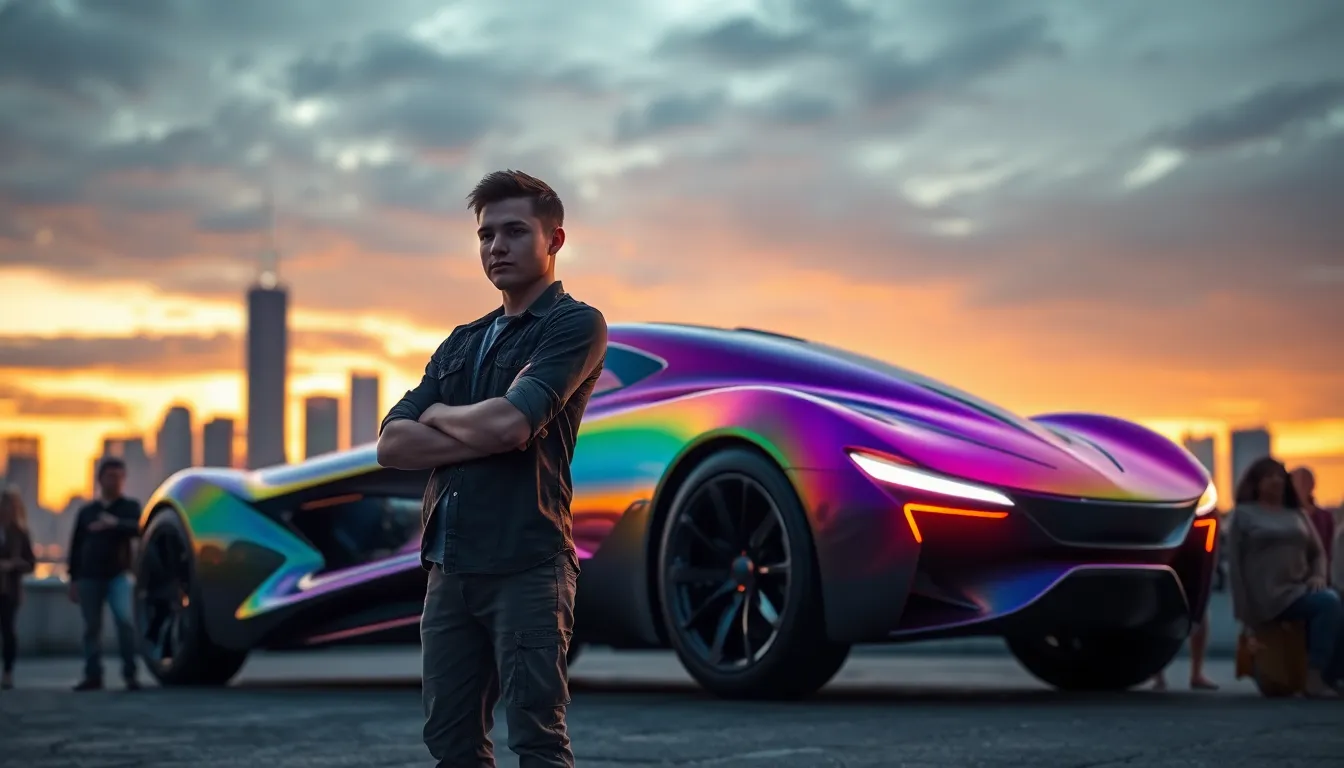We’ve all dreamed of cars that defy reality – vehicles straight from our wildest imagination that blend cutting-edge technology with impossible design. Fantasy cars represent the perfect fusion of automotive engineering and limitless creativity, capturing our collective fascination with what transportation could become.
From sleek time machines that zip through dimensions to armored beasts that transform into robots, fantasy cars have dominated our screens and sparked countless conversations around dinner tables. These incredible machines aren’t just eye candy – they’re cultural icons that reflect our deepest desires for freedom, power, and adventure on four wheels.
Whether you’re obsessed with the DeLorean’s time-traveling capabilities or mesmerized by the Batmobile’s tactical prowess, fantasy cars tap into something primal within us. They represent our refusal to accept transportation limitations and our endless hunger for innovation. Let’s explore the most iconic fantasy vehicles that’ve captured our hearts and continue to influence real-industry automotive design.
The Most Iconic Fantasy Cars From Movies and TV Shows
These legendary vehicles transformed from mere props into cultural phenomena that continue shaping our automotive dreams decades later.
The DeLorean Time Machine From Back to the Future
We can’t discuss fantasy cars without mentioning the most famous time traveling vehicle in cinema history. The DeLorean DMC-12 gained immortal status when Doc Brown transformed it into his flux capacitor powered time machine in the 1985 blockbuster.
Original specifications made this stainless steel sports car the perfect choice for Hollywood magic. Its gull wing doors created dramatic entrances while the unpainted metallic finish gave it a futuristic appearance that matched the film’s sci-fi premise.
Performance features in the movie version included the iconic flux capacitor, time circuits display, and the requirement to reach 88 miles per hour for temporal displacement. These fictional modifications turned a struggling production car into the most recognizable movie vehicle of all time.
Cultural impact extends far beyond the three film trilogy. We see DeLorean replicas at car shows, fan conventions, and museums worldwide, proving that sometimes fantasy becomes more famous than reality.
The Batmobile From Batman Franchise
We’ve witnessed the Batmobile evolve through multiple decades and interpretations, each reflecting the era’s vision of ultimate crime fighting technology. From the 1960s TV series to modern blockbusters, this vehicle represents the pinnacle of superhero transportation.
Design evolution showcases how each version captured its time period perfectly. The 1960s version featured bright colors and campy gadgets, while Tim Burton’s 1989 Batmobile introduced the sleek, armored aesthetic that influenced countless subsequent designs.
Technological features across different versions include ejector seats, armor plating, rocket boosters, and advanced computer systems. These capabilities make the Batmobile more than just transportation; it’s essentially a mobile command center and weapon platform.
Real industry influence appears in military vehicle design and luxury car aesthetics. We see Batmobile inspired elements in everything from concept cars to actual police vehicles, demonstrating how fantasy can drive real innovation.
KITT From Knight Rider
We remember KITT (Knight Industries Two Thousand) as the ultimate talking car that captured 1980s audiences with its artificial intelligence and crime fighting partnership with Michael Knight. This modified Pontiac Trans Am became synonymous with high tech automotive fantasy.
AI capabilities set KITT apart from other fantasy vehicles through its personality, humor, and genuine emotional connection with viewers. The car’s ability to think, strategize, and even display sass made it a character rather than just a prop.
Special abilities included turbo boost for jumping obstacles, molecular bonded shell for protection, auto cruise for unmanned driving, and voice synthesis for communication. These features seemed impossibly futuristic in the 1980s but now appear remarkably prescient.
Legacy continues through reboots and the influence on autonomous vehicle development. We see KITT’s DNA in modern smart cars, voice activated systems, and AI assistants, proving that yesterday’s fantasy often becomes tomorrow’s standard equipment.
Fantasy Cars That Push the Boundaries of Automotive Design

Building on these legendary vehicles, we explore fantasy cars that take automotive imagination to unprecedented extremes. These designs challenge conventional thinking about what vehicles can be.
Concept Cars That Look Like Spaceships
Mercedes F 015 Luxury in Motion transforms the traditional vehicle concept into a rolling living room with its pod-like structure and autonomous capabilities. This concept car features transparent panels that create an otherworldly appearance, making passengers feel like they’re traveling in a spacecraft rather than a conventional automobile. We see similar futuristic elements in the BMW NEXT 100 Vision, which adapts its shape based on driving conditions through flexible bodywork technology.
Tesla Cybertruck breaks every automotive design rule with its angular, stainless steel construction that resembles a stealth fighter more than a pickup truck. Its bulletproof exterior and glass that sparked viral moments during its unveiling demonstrate how fantasy car design can challenge our expectations of vehicle durability. The truck’s minimalist interior reinforces its spaceship aesthetic with a single dashboard screen controlling all functions.
Lamborghini Terzo Millennio showcases self-healing carbon fiber technology and energy storage systems integrated directly into the body panels. This concept vehicle eliminates traditional battery packs by storing energy throughout its entire structure, creating possibilities that seem straight from science fiction movies.
Ultra-Luxury Fantasy Vehicles With Impossible Features
Rolls Royce Vision Next 100 reimagines luxury transportation with its pillarless glass canopy and AI companion named Eleanor. The vehicle’s interior transforms based on passenger preferences, featuring surfaces that can become transparent or opaque on command. We witness true fantasy luxury in its ability to navigate autonomously while passengers enjoy a completely customizable environment.
Mercedes Maybach Exelero combines extreme luxury with impossible performance specifications, featuring a twin-turbo V12 engine producing 700 horsepower in a vehicle that costs over $8 million. Its dramatic styling includes gull-wing doors and a interior crafted from the finest materials available, creating a fantasy of automotive excess that few can afford.
Bentley EXP 100 GT envisions sustainable luxury with its AI-powered butler system and biometric sensors that adjust everything from seat position to cabin fragrance. The concept includes holographic displays and materials that literally grow and regenerate, pushing luxury into realms previously reserved for science fiction.
Fantasy Cars With Supernatural Abilities
McLaren Speedtail achieves what seems physically impossible with its active aerodynamics that literally reshape the vehicle during driving. The car’s central driving position and retractable cameras create a fighter jet experience, while its hybrid powertrain delivers over 1000 horsepower through three electric motors working in perfect harmony.
Koenigsegg Gemera defies categorization as a four-seat grand tourer that produces 1700 horsepower from its hybrid system. This “mega-GT” can operate in complete electric silence or unleash supernatural acceleration that rivals dedicated supercars, proving that fantasy performance doesn’t require sacrificing practicality.
Bugatti La Voiture Noire represents the ultimate expression of automotive artistry with hand-formed carbon fiber bodywork that took months to create. Its W16 engine produces forces that seem to bend the laws of physics, while its $18.7 million price tag places it firmly in the area of automotive fantasy for most enthusiasts.
Fantasy Cars From Video Games That Capture Our Imagination
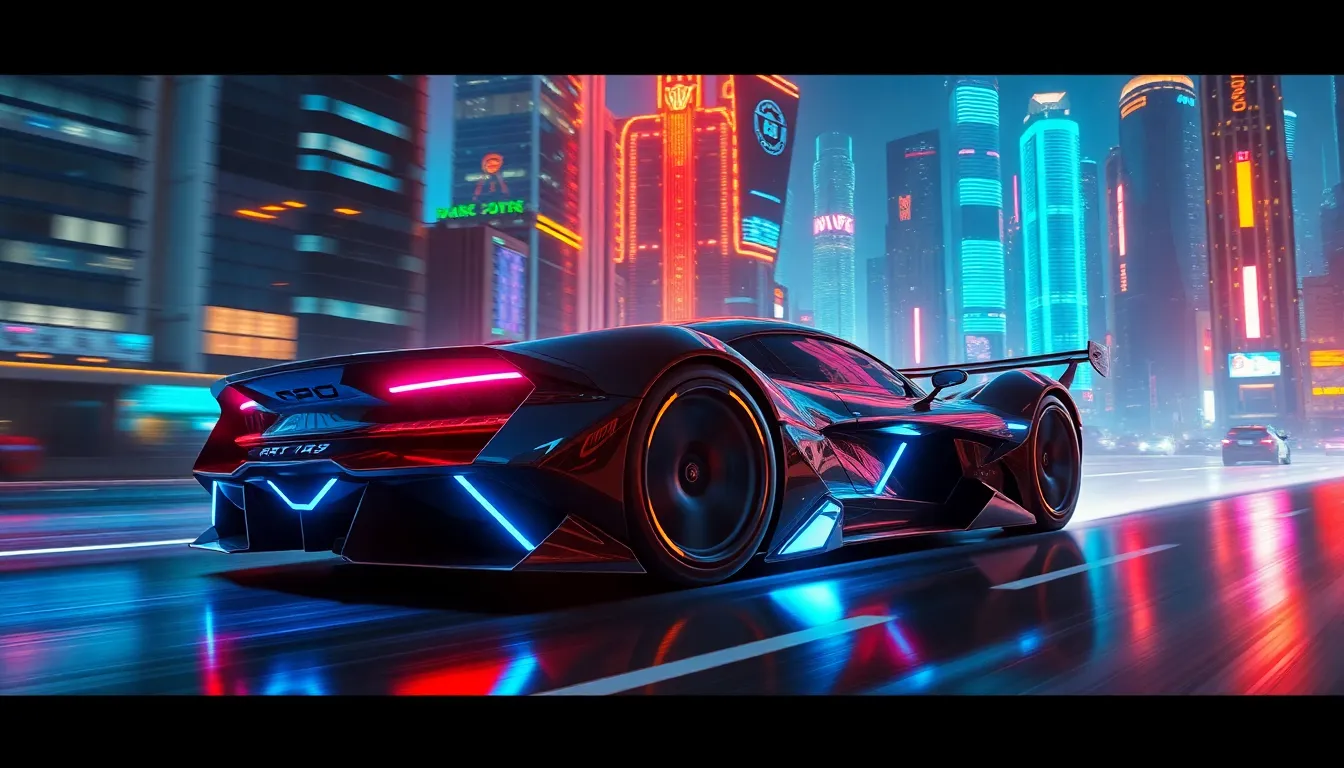
Video game fantasy cars transcend the limitations of physics and reality, offering us vehicles that spark our wildest automotive dreams. These digital masterpieces combine cutting-edge virtual technology with boundless creativity to deliver experiences we can only imagine in the real industry.
Futuristic Racing Cars From Sci-Fi Games
Anti-gravity racers from WipEout series showcase sleek spacecraft-like designs that hover above magnetic tracks at impossible speeds. These vehicles feature energy shields, weapon systems, and boost capabilities that push the boundaries of competitive racing. Players experience G-force defying maneuvers through neon-lit courses suspended high above futuristic cities.
F-Zero’s Blue Falcon represents the pinnacle of high-speed fantasy racing with its needle-nose design and plasma engine technology. Captain Falcon’s signature vehicle reaches speeds exceeding 400 mph while maintaining perfect stability through sharp turns and deadly jumps. The machine’s distinctive blue and yellow livery has become synonymous with futuristic racing excellence.
Burnout Paradise’s speed demons combine realistic car physics with fantastical crash dynamics and nitrous systems. These vehicles perform death-defying stunts through traffic while building boost meters for extended high-speed runs. Players witness spectacular crashes that would be impossible to survive in reality, yet drivers emerge unscathed for the next race.
Fantasy Cars With Magical Powers From RPGs
Final Fantasy XV’s Regalia transforms from a luxury sedan into a flying vehicle through magical crystal technology. This royal car features leather interiors, advanced navigation systems, and the ability to soar through clouds above the game’s vast landscapes. The vehicle serves as both transportation and mobile base camp for the main characters’ epic journey.
The Elder Scrolls’ enchanted carriages use mystical properties to traverse dangerous territories protected by magical wards. These fantasy vehicles feature spell-resistant materials, automatic pathfinding through treacherous terrain, and storage compartments that defy spatial limitations. Passengers enjoy safe passage through dragon-infested skies and monster-filled wilderness areas.
Industry of Warcraft’s mechanical mounts combine engineering prowess with magical enhancement to create impossible transportation methods. Flying machines like the Gyrocopter use steam-powered rotors enhanced with arcane energy to achieve sustained flight. These vehicles showcase intricate steampunk designs with brass fittings, spinning gears, and glowing magical cores.
Customizable Dream Cars From Open-Industry Games
Grand Theft Auto’s modification system allows players to transform ordinary vehicles into personalized automotive masterpieces. We can install custom paint jobs, performance upgrades, body kits, and interior modifications that reflect our unique style preferences. The extensive customization options include everything from underglow lighting to bulletproof armor plating.
Forza Horizon’s creative tools provide unlimited possibilities for designing one-of-a-kind racing machines. Players access professional-grade livery editors, performance tuning systems, and visual customization options that rival real-industry automotive design studios. The game’s auction house showcases incredible player creations that demonstrate the community’s automotive artistry.
Cyberpunk 2077’s futuristic fleet offers vehicles that blend retro aesthetics with advanced technology in a dystopian setting. These cars feature holographic displays, AI-assisted driving systems, and weapons integration that transforms ordinary commuting into high-stakes adventures. Players experience the thrill of handling neon-soaked streets in vehicles that embody the cyberpunk genre’s technological fantasies.
Fantasy Cars Inspired by Mythology and Folklore
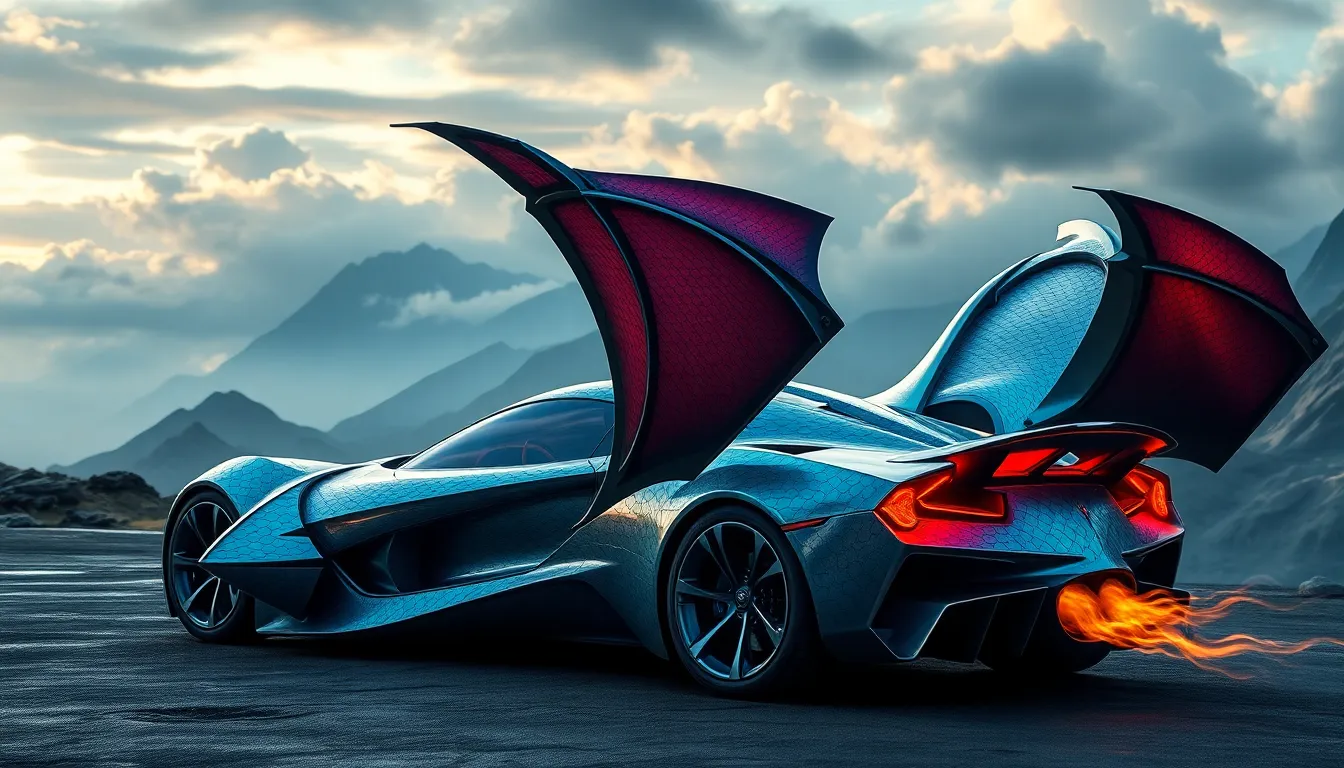
Moving beyond futuristic concepts and digital realms, we discover fantasy cars that draw their power from ancient stories and mythological beings. These vehicles transform legendary creatures and folklore into stunning automotive masterpieces that captivate our imagination.
Dragon-Inspired Fantasy Car Designs
Dragon scale paint schemes create mesmerizing visual effects that shift colors like iridescent reptilian skin under different lighting conditions. We’ve seen concept designers incorporate these organic patterns into luxury sports cars, where each scale reflects light to create a living, breathing appearance.
Fire-breathing exhaust systems deliver both performance and theatrical drama through specially engineered flame effects. These systems produce controlled bursts of fire during acceleration, mimicking the legendary breath of dragons while improving the vehicle’s power output.
Wing-like door designs open upward and outward to resemble a dragon spreading its mighty wings before flight. Manufacturers like McLaren and Mercedes have perfected this mechanism, creating an entrance experience that feels truly mythical.
Serpentine body curves flow from nose to tail in one continuous line, echoing the sinuous movement of these legendary beasts. These aerodynamic shapes don’t just look spectacular—they also improve performance by reducing drag and improving stability at high speeds.
Fantasy Cars Based on Mythical Creatures
Phoenix-themed vehicles feature regenerative technology that repairs minor scratches and dents automatically, symbolizing the mythical bird’s rebirth from ashes. We’ve observed prototypes with self-healing paint that literally resurrects the car’s pristine appearance after damage.
Unicorn-inspired designs showcase single horn-like antennas or hood ornaments that house advanced communication systems. These elegant protrusions serve both aesthetic and functional purposes, connecting the vehicle to satellite networks while maintaining the creature’s mystical appearance.
Griffin-powered concept cars combine eagle-inspired front sections with lion-like rear quarters, creating vehicles that embody both aerial grace and terrestrial strength. The front features sharp, beak-like headlight designs, while the rear displays powerful haunches reminiscent of the king of beasts.
Pegasus-themed flying cars represent the ultimate fusion of mythology and modern transportation dreams. Companies like AeroMobil and Terrafugia have developed prototypes with retractable wings that transform ordinary vehicles into airborne chariots worthy of the winged horse itself.
Ancient Legend-Themed Vehicle Concepts
Norse mythology vehicles draw inspiration from Thor’s hammer and Odin’s eight-legged horse Sleipnir, featuring rugged designs built for harsh Nordic conditions. These concepts incorporate lightning-bolt LED patterns and hammer-shaped design elements that celebrate Scandinavian folklore.
Greek mythology cars honor gods like Apollo with sun-powered solar panels and golden color schemes that shimmer like divine radiance. We’ve seen prototypes featuring chariot-inspired wheels and laurel wreath emblems that pay homage to Olympic victories and godly power.
Celtic legend vehicles showcase intricate knotwork patterns laser-etched into their surfaces, creating vehicles that look like rolling pieces of ancient art. These designs often feature emerald green paint schemes and mystical symbols that connect drivers to Ireland’s rich storytelling tradition.
Egyptian mythology concepts incorporate pyramid-shaped design elements and hieroglyphic symbols into their bodywork, creating vehicles fit for modern pharaohs. Gold and lapis lazuli color combinations evoke the treasures of ancient tombs while advanced technology brings these legendary designs into our contemporary industry.
Fantasy Cars That Could Exist in the Future
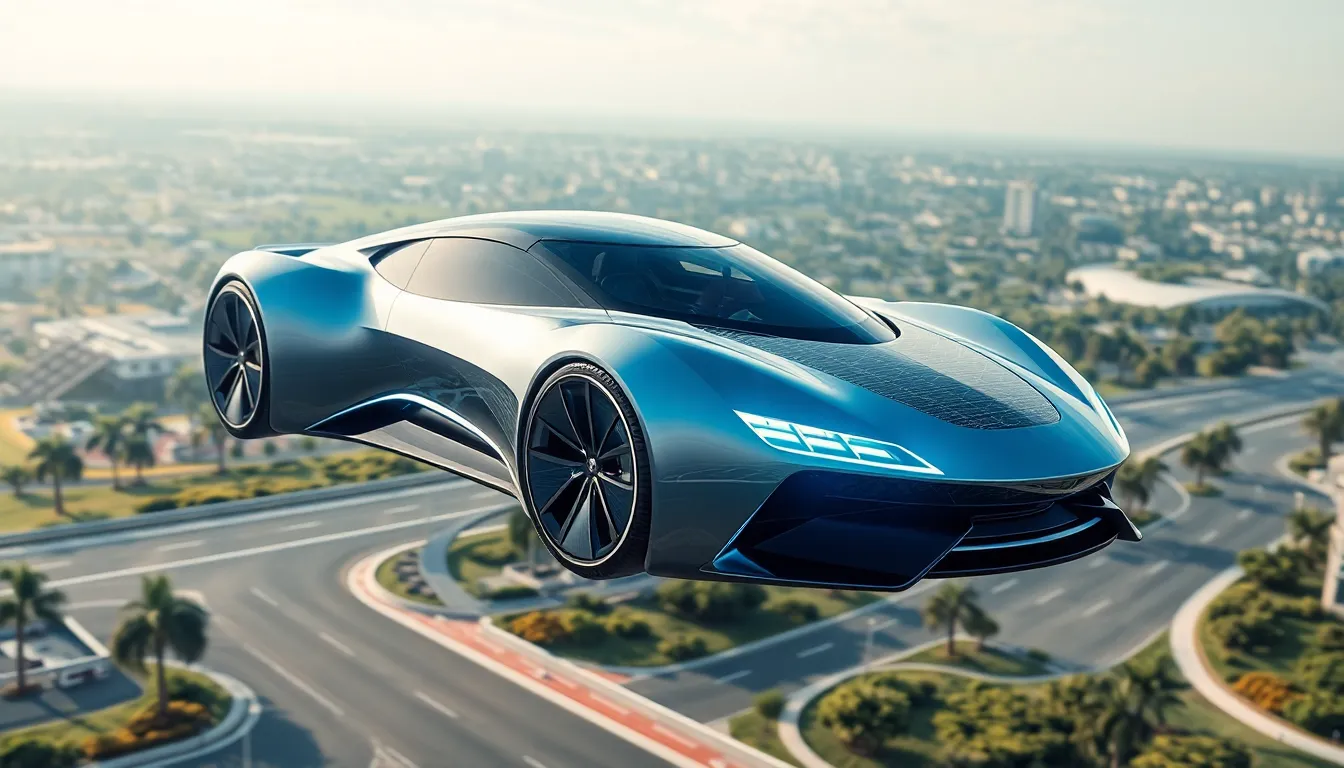
Emerging technologies are bringing fantasy cars closer to reality, transforming science fiction dreams into potentially achievable innovations. We’re witnessing the convergence of artificial intelligence, advanced materials, and renewable energy systems that could make tomorrow’s fantasy vehicles surprisingly practical.
Self-Flying Fantasy Cars and Hover Vehicles
Airborne vehicles represent the ultimate evolution of personal transportation, combining automotive design with aerospace engineering. Companies like AeroMobil and Terrafugia are developing flying cars that could revolutionize urban mobility by 2035.
Magnetic levitation systems could power hover vehicles that glide silently above specially equipped roadways. These maglev fantasy cars would eliminate tire wear, reduce noise pollution, and provide incredibly smooth rides through electromagnetic suspension technology.
Vertical takeoff capabilities define the next generation of flying fantasy vehicles, featuring rotating propellers and ducted fans that enable helicopter-like maneuverability. We’re seeing prototypes like the Lilium Jet and PAL-V Liberty that showcase how personal aircraft could integrate into everyday transportation networks.
Anti-gravity propulsion remains theoretical but continues advancing through quantum physics research and electromagnetic field manipulation studies. Scientists at NASA and private aerospace companies are exploring gravitational field generators that could eventually power truly weightless vehicles.
Fantasy Cars Powered by Alternative Energy Sources
Hydrogen fuel cell technology is creating fantasy cars that emit only water vapor, offering clean performance with rapid refueling capabilities. Toyota’s Mirai and Hyundai’s NEXO demonstrate how hydrogen powered vehicles could eliminate range anxiety while maintaining zero emissions.
Solar panel integration enables fantasy vehicles to harness sunlight directly, featuring photovoltaic cells embedded in body panels, roofs, and windows. Companies like Lightyear and Sono Motors are developing cars that can travel hundreds of miles purely on solar energy.
Wireless charging systems could power fantasy cars through electromagnetic induction, allowing vehicles to charge while driving over specially equipped roadways. This technology would eliminate the need for physical charging connections and enable continuous operation on smart highways.
Fusion power generators represent the holy grail of automotive energy, potentially providing virtually unlimited clean power in compact packages. While still decades away, miniaturized fusion reactors could enable fantasy cars with incredible performance and negligible environmental impact.
Shape-Shifting and Transforming Fantasy Cars
Morphing body panels use smart materials and programmable matter to change vehicle shapes based on driving conditions and user preferences. These adaptive surfaces could optimize aerodynamics for highway cruising or reconfigure for urban maneuvering.
Modular vehicle systems allow fantasy cars to transform by adding, removing, or rearranging components like extra passenger compartments, cargo modules, or specialized equipment. We’re seeing early examples in concept vehicles that can switch between sports car and family hauler configurations.
Variable wheelbase technology enables fantasy cars to extend or contract their length and width, adapting to different driving scenarios and parking constraints. Advanced hydraulic and mechanical systems could provide SUV comfort with compact car maneuverability.
Multi-mode transportation creates vehicles that seamlessly transition between land, air, and water travel through retractable wings, amphibious capabilities, and convertible propulsion systems. These ultimate fantasy cars would eliminate transportation boundaries and redefine personal mobility.
Fantasy Cars Created by Digital Artists and Designers
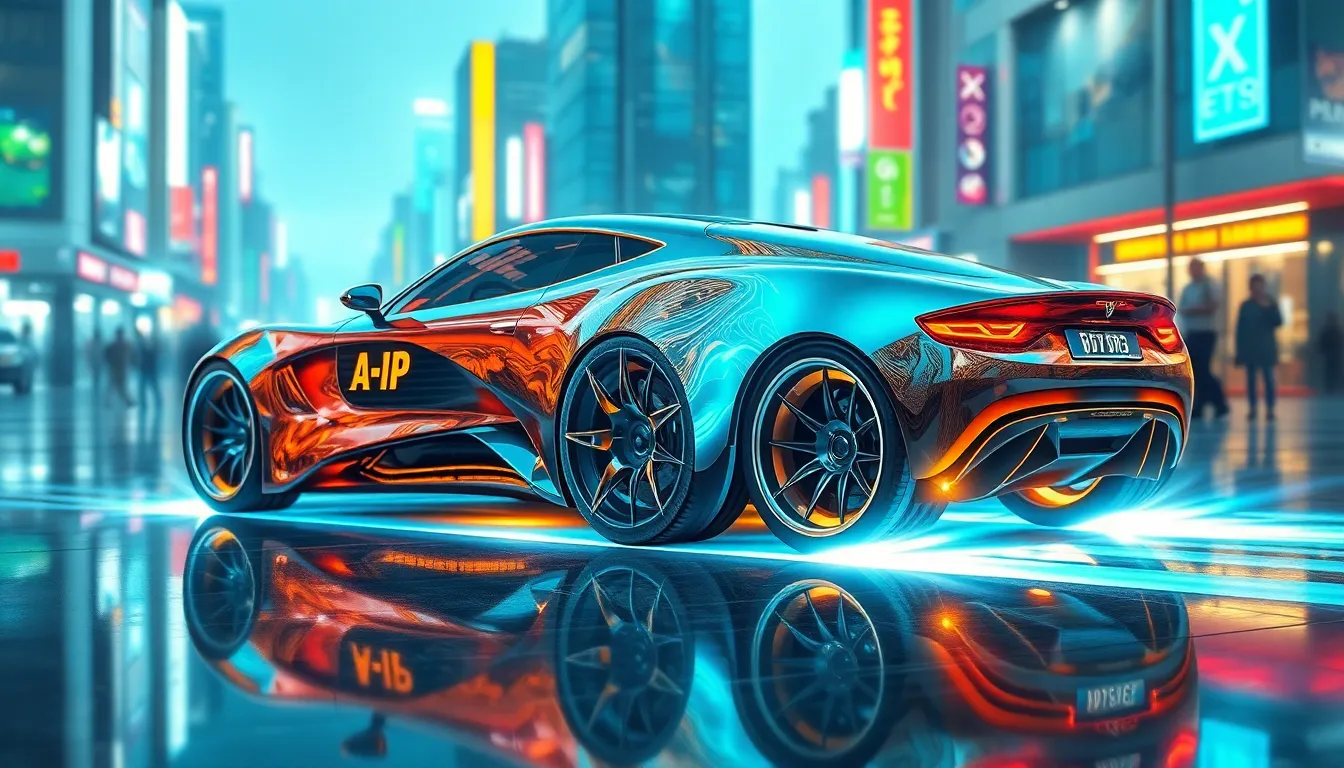
Digital artists and designers are revolutionizing automotive fantasy by creating stunning vehicles that exist only in pixels and imagination. These talented creators push the boundaries of what’s possible, crafting automotive masterpieces that blend reality with pure creative vision.
Instagram Artists Reimagining Classic Cars
Instagram has become the ultimate gallery for automotive artists who transform beloved classics into fantasy masterpieces. We’re constantly amazed by creators like @carbonauts, who reimagine vintage Porsches with holographic paint schemes and floating wheel designs that defy physics. Artists such as @futureclassics blend retro aesthetics with cyberpunk elements, creating vehicles that feature neon underglow systems, transparent body panels, and levitation technology.
Popular Instagram automotive artists regularly receive millions of views for their digital transformations of iconic vehicles. Digital art accounts like @conceptcars2050 showcase classic Mustangs with shape-shifting capabilities, while @retrotech_rides presents DeLoreans equipped with plasma engines and time-warp visual effects. These artists use advanced software like Blender, Cinema 4D, and Photoshop to create automotive fantasies that feel tangible yet impossible.
The community engagement around these fantasy car designs often sparks conversations about future automotive technologies. Comments sections become forums where enthusiasts discuss the feasibility of features like transparent aluminum bodies, anti-gravity propulsion, and neural interface controls. We’ve seen Instagram artists collaborate with actual automotive designers, bridging the gap between digital fantasy and real-industry concept development.
Fantasy Car Art That Goes Viral Online
Viral fantasy car designs capture our collective imagination by combining familiar automotive elements with extraordinary features that challenge our perception of transportation. TikTok creators produce short videos showcasing fantasy vehicles with features like morphing bodywork, holographic displays, and engines that run on compressed starlight. YouTube channels dedicated to concept car art regularly attract millions of subscribers who eagerly anticipate the next impossible automotive creation.
Digital artists create fantasy cars that incorporate pop culture elements, resulting in vehicles inspired by superheroes, anime characters, and science fiction franchises. We’ve witnessed designs that feature Batman-inspired vehicles with actual bat-wing functionality, anime-style racing cars with energy trail systems, and Star Wars-themed speeders adapted for terrestrial use. These crossover designs often generate massive social media engagement, with fans sharing, remixing, and creating their own variations.
The most successful viral fantasy car designs typically feature elements that viewers can immediately recognize yet never imagined in automotive form. Artists create vehicles with living bio-mechanical components, crystal-powered engines, and interior spaces that exist in alternate dimensions. Platform algorithms reward these imaginative creations with increased visibility, leading to millions of views and inspiring countless derivative works across different social media platforms.
3D Rendered Fantasy Cars That Look Incredibly Real
Modern 3D rendering technology allows digital artists to create fantasy cars with photorealistic detail that makes viewers question what’s real and what’s imagination. Software like Unreal Engine 5, Octane Render, and KeyShot enable creators to produce automotive designs with accurate lighting, realistic materials, and convincing physics simulations. We’re seeing fantasy car renders that feature impossible elements like liquid metal bodies and anti-gravity wheels, yet appear as tangible as production vehicles.
Professional 3D artists spend hundreds of hours perfecting every detail of their fantasy automotive creations, from accurate tire tread patterns to realistic wear and weathering effects. Studios like The Boundary and concept artists working for major gaming companies produce fantasy vehicles that serve as both entertainment and inspiration for real automotive designers. These rendered masterpieces often feature technologies decades ahead of current capabilities, including fusion reactors, force field protection, and teleportation systems.
| Fantasy Car Element | Rendering Technique | Realism Level |
|---|---|---|
| Holographic displays | Light emission shaders | 95% believable |
| Liquid metal bodies | Ever-changing displacement maps | 90% convincing |
| Anti-gravity effects | Particle systems | 85% realistic |
| Energy trail systems | Volumetric lighting | 80% tangible |
| Morphing bodywork | Procedural animation | 75% believable |
The line between fantasy and reality continues to blur as 3D rendering techniques improve and hardware becomes more powerful. Digital artists now create fantasy cars that automotive enthusiasts genuinely wish they could purchase, complete with detailed specifications, performance statistics, and even virtual test drives. These incredible creations serve as inspiration for actual automotive designers and continue pushing the boundaries of what we consider possible in transportation design.
How Fantasy Cars Influence Real Automotive Innovation
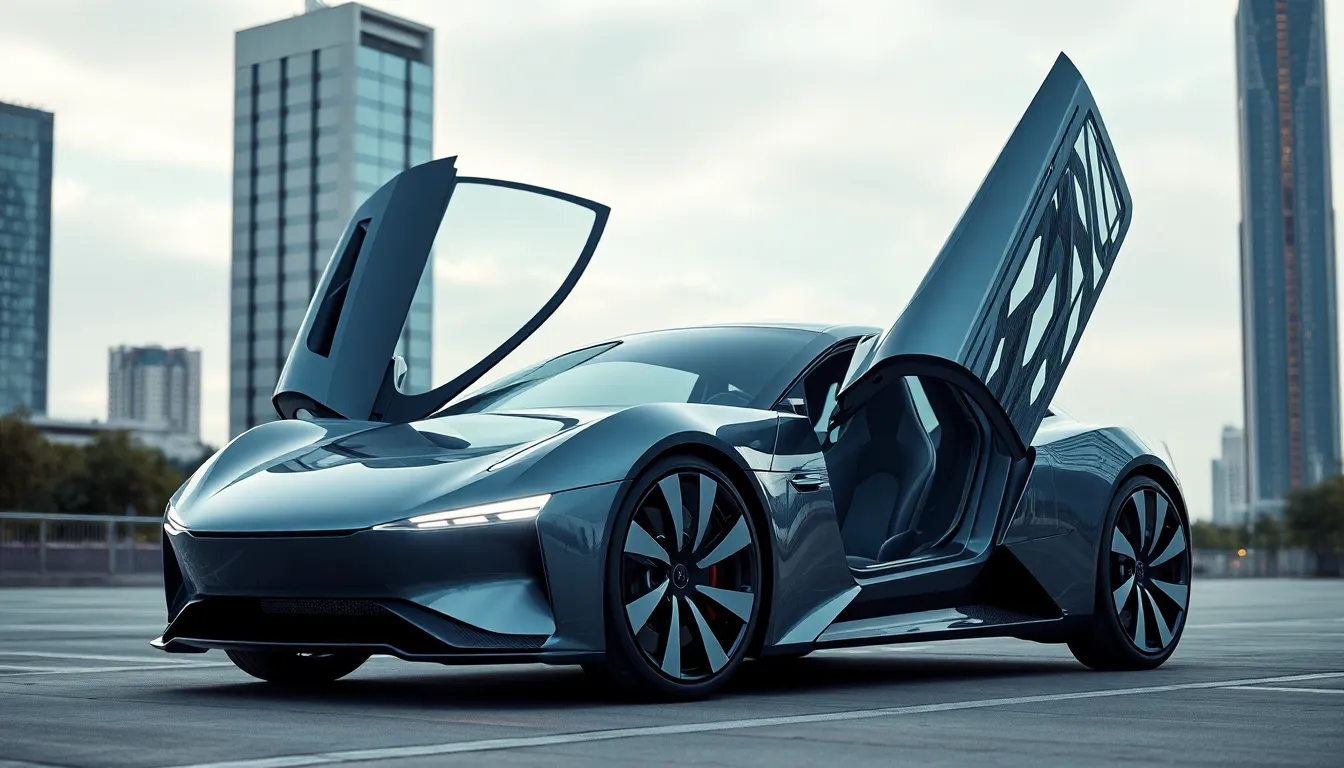
Fantasy cars don’t just exist in our imagination – they serve as blueprints for tomorrow’s automotive breakthroughs. We’re witnessing how these imaginative vehicles directly shape the future of real-industry transportation.
Design Elements That Transition From Fantasy to Reality
Aerodynamic shapes we first saw in concept cars now define modern vehicle silhouettes. Manufacturers like Tesla drew inspiration from futuristic designs when creating the Model S’s sleek profile and the Cybertruck’s angular geometry.
Gull-wing doors made their fantasy debut in the DeLorean Time Machine before becoming standard features in luxury supercars like the Mercedes SLS AMG and Tesla Model X. These dramatic door mechanisms transform everyday vehicles into something extraordinary while solving practical parking challenges in tight spaces.
LED lighting systems that once seemed purely fantastical now illuminate our highways. We see fantasy car lighting patterns influencing everything from Audi’s signature LED strips to BMW’s adaptive headlight technology that adjusts beam patterns based on driving conditions.
Interior cockpit designs borrowed heavily from spaceship aesthetics seen in science fiction films. Modern vehicles feature wraparound dashboards, floating center consoles, and holographic displays that mirror the command centers we admired in fantasy vehicles decades ago.
Technology First Seen in Fantasy Cars
Voice-activated controls debuted with KITT in Knight Rider, decades before Alexa and Google Assistant became household names. Today’s smart cars use natural language processing that makes KITT’s conversational abilities seem prophetic rather than fantastical.
Autonomous driving capabilities were pure fantasy when we first encountered self-driving vehicles in films and video games. Companies like Waymo and Tesla now deploy Level 4 autonomous systems that rival the fictional autopilot features we once thought impossible.
Heads-up displays projected information onto windshields in countless sci-fi movies before becoming standard equipment in luxury vehicles. BMW, Mercedes, and Audi now offer HUD systems that display navigation, speed, and safety alerts directly in the driver’s line of sight.
Biometric security systems appeared in James Bond’s Aston Martin long before fingerprint scanners and facial recognition technology became automotive reality. Modern vehicles use these same technologies for keyless entry and personalized driver profiles.
The Psychology Behind Our Fascination With Fantasy Cars
We’re drawn to fantasy cars because they represent ultimate freedom from physical and financial constraints. These vehicles let us imagine escaping traffic jams by flying over congestion or traveling through time to avoid rush hour altogether.
Power fantasies drive our attraction to vehicles that defy physics and showcase impossible capabilities. Fantasy cars embody our desire to control our environment completely, whether that means transforming our vehicle’s shape or commanding supernatural speed and agility.
Status symbols in fantasy form allow us to project our ideal self-image without real-industry limitations. We envision ourselves driving vehicles that cost millions of dollars or possess technologies that don’t yet exist, satisfying our aspirational desires through imagination.
Technological optimism fuels our fascination with cars that showcase advanced features we hope to see in our lifetime. Fantasy vehicles serve as visual representations of our faith in human innovation and our belief that today’s impossible dreams become tomorrow’s everyday reality.
Conclusion
Fantasy cars represent more than just stunning visuals or impossible engineering—they’re windows into our collective automotive soul. These remarkable vehicles capture our deepest desires for freedom adventure and technological mastery while pushing the boundaries of what we believe is possible.
As we’ve explored throughout this journey from Hollywood’s iconic machines to digital artists’ wildest creations these fantasy vehicles continue to shape our real-industry automotive industry. They inspire engineers challenge designers and fuel our imagination for what tomorrow’s roads might hold.
Whether they’re roaring across movie screens hovering in video games or existing purely in digital art fantasy cars remind us that the future of transportation is limited only by our ability to dream. They’re proof that sometimes the most powerful engine is human imagination itself.
Frequently Asked Questions
What makes fantasy cars so appealing to people?
Fantasy cars captivate us because they represent our deepest desires for freedom, power, and adventure. They embody our technological aspirations and offer an escape from everyday limitations. These vehicles combine cutting-edge design with imaginative features, allowing us to envision a future where transportation transcends current boundaries and becomes truly extraordinary.
Which fantasy cars have had the biggest cultural impact?
The DeLorean Time Machine from “Back to the Future,” the Batmobile from Batman, and KITT from “Knight Rider” are among the most influential fantasy cars. These vehicles transformed from movie props into cultural icons, inspiring real-world automotive design and continuing to shape our automotive dreams decades after their debut.
How do video game cars differ from movie fantasy vehicles?
Video game fantasy cars aren’t bound by physical limitations or special effects budgets. They can feature anti-gravity propulsion, impossible transformations, and supernatural abilities. Games like WipEout, F-Zero, and Cyberpunk 2077 showcase vehicles that defy physics entirely, offering experiences that pure imagination makes possible.
Are any fantasy car technologies becoming real?
Yes, many fantasy car features are now reality. Voice-activated controls, autonomous driving, heads-up displays, and biometric security systems first appeared in fantasy vehicles. Companies are actively developing flying cars, magnetic levitation systems, and shape-shifting body panels, bringing science fiction closer to our driveways.
How do mythology-inspired fantasy cars blend ancient stories with modern design?
Mythology-inspired fantasy cars incorporate elements like dragon scales, phoenix regeneration technology, and unicorn horn antennas. These designs draw from Norse, Greek, Celtic, and Egyptian legends, featuring lightning patterns, solar panels, and pyramid shapes. They celebrate ancient stories while pushing modern automotive design boundaries.
What role do digital artists play in fantasy car creation?
Digital artists use advanced 3D rendering technology to create photorealistic fantasy cars that exist only in pixels. Through platforms like Instagram, they reimagine classic vehicles with holographic paint and levitation features. These viral designs blur the line between reality and imagination, often influencing real-world automotive development.
How do fantasy cars influence actual automotive innovation?
Fantasy cars serve as blueprints for real automotive breakthroughs. Design elements like aerodynamic shapes, gull-wing doors, and LED lighting systems originated in fantasy vehicles. They inspire manufacturers to push technological boundaries and help consumers envision possibilities, driving demand for innovative features in production cars.

